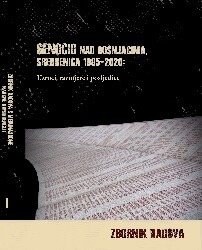Genocid nad Bošnjacima Srebrenice
Genocide against the Bosniaks of Srebrenica
Author(s): Alma Hajrić-Ćaušević, Almir Grabovica
Subject(s): Local History / Microhistory, Political history, Studies in violence and power, Victimology, Transformation Period (1990 - 2010), Identity of Collectives
Published by: Institut za istraživanje zločina protiv čovječnosti i međunarodnog prava Univerziteta u Sarajevu
Keywords: Republic of Bosnia and Herzegovina; aggression; genocide; crimes; Podrinje; enclave; UN safe zone; July 1995;
Summary/Abstract: During the aggression against the Republic of Bosnia and Herzegovina (1992–1995), the most serious form of crime against humanity and international law was committed against Bosniaks - genocide, which was confirmed by the Hague Tribunal for Yugoslavia and the International Court of Justice. According to previous findings, court practice and scientific research, genocide in all its five acts (Article two of the Convention on the Prevention and Punishment of the Crime of Genocide from 1948) was committed in and around Srebrenica. In this paper, we will present all the most important events, ie the chronology of the genocide from July 11, 1995 to July 22, 1995. It is important to point out that what happened in Srebrenica in July 1995 has been strategically planned and announced since 1992, and gradually realized in the years that followed. Unfortunately, gaining the status of a UN safe zone on April 16, 1993, did not help Bosniaks in Srebrenica either. Between 11 and 22 July 1995, the Republika Srpska Armed Forces and Police, in co-operation with units from the Federal Republic of Yugoslavia and the Republika Srpska Krajina, and foreign mercenaries, in accordance with Greater Serbia ideology, policy and practice, and the occupation of the United Nations safe zone of Srebrenica, forcibly relocated all Bosniak women and children and captured, imprisoned and executed thousands of men and boys and buried them in mass graves in secret places. In that period, the largest mass murder in Europe after the Second World War took place, while the “international community” did nothing to stop the commission of crimes by monstrous methods. We believe that it is important to point out the genocide and other crimes committed in the period from 1992 to 1995 in different ways on a daily basis, all with the aim that they would never and nowhere be repeated. In this regard, we decided to use this paper to point out chronologically the most important facts of the genocide of Bosniaks in and around Srebrenica in July 1995.
- Page Range: 483-500
- Page Count: 18
- Publication Year: 2021
- Language: Bosnian
- Content File-PDF

